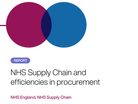NHS Supply Chain: Finding Further Savings in Procurement

The report from the National Audit Office (NAO) has found the organisation is not using the strength of its spending power when procuring medical equipment and consumables to make further savings.. The research also says it has continued to spend more than £3 billion outside NHS Supply Chain, its purpose-built procurement route.
The UK’s independent public spending watchdog examined how effectively Supply Chain Coordination Limited (NHS Supply Chain) is making efficiencies across NHS procurement, and whether it has achieved its objectives of saving money and increasing its share of products bought through it by the NHS.
How much does NHS Supply Chain spend?
NHS Supply Chain was first established in 2019 as part of a strategy to find savings thanks to the significant buying power of the National Health Service. For 2023-24 NHS Supply Chain has published an estimate that annual spending on products is around £8 bn ($10.2bn USD). This value is based on incomplete data, as 55 of the regional UK trusts do not report any data.
The procurement organisation manages more than 8 million orders per year across more than 129,000 order points and over 16,000 locations. They deliver over 35 million lines of picked goods to the NHS annually and its systems consolidate orders from over 1100 suppliers. The core mission is to bring value to NHS partners, helping them save time and money in removing duplication of overlapping contracts.
What are the NHS Supply Chain savings targets?
When NHS Supply Chain was founded in 2019, the Department for Health and Social Care (DHSC) set NHS Supply Chain a target to deliver £2.4 billion savings by 2023-24. As of 2022-23, it told the NAO that it had exceeded its £2.4 billion savings target – but although NHS Supply Chain reported progress against this target to NHS England (NHSE) on a quarterly basis, neither NHSE nor the DHSC has validated or checked these savings. The difficultly has come in assessing procurement progress because of different methods being used to report savings. A new methodology to report procurement efficiency has been developed and should be ready for April 2024. Supply Chain is now pursuing a new savings target of £1 billion from January 2022 to 2030 (£500 million by 2026).
The report from the NAO states that regional NHS trusts spend approximately £3.4 billion outside of NHS Supply Chain’s procurement. The smaller organisations are largely free to purchase goods outside Supply Chain, but in order for the wider buying organisation to achieve its savings objectives – to harness the NHS’s spending power – NHS Supply Chain needs to persuade them to use it to purchase goods. The research also states there is a still lot of variation in the prices trusts pay. One example raised says for each hip replacement stem part purchased by the NHS in 2022-23, individual trusts paid up to £490, with a median price of £333. Supply Chain’s price for the same product was £258 which was the lowest price for that product.
What strategies can be used to improve the amount of spending through NHS Supply Chain?
The NAO is recommending that NHSE should use its data on trusts’ spending to understand and challenge why trusts are not using NHS Supply Chain and incentivise and encourage greater use of NHS Supply Chain, and that NHS Supply Chain should improve its understanding of why some customers are unsatisfied with its services and develop a targeted action plan to make substantial improvements in satisfaction.
“Delivering the right products for the NHS, on time and at the best available price is essential to make every pound count for patients. The NHS has enormous buying power, but it is not yet making the most of it,” said Gareth Davies, Head of the NAO.
“Supply Chain needs to do more to deliver, and to show that it is delivering, for the NHS. In response, trusts need to make use of the NHS’s buying power to secure the lower costs Supply Chain can bring, with support and clear direction from NHSE.”
How have NHS Supply Chain responded to the NAO report?
In a statement NHS Supply Chain have welcomed the NAO report into the efficiences in procurement, and the recommendations they have published. It adds that the redesign of its operating model supports its capability to implement the report’s recommendations.
“We are committed to continuing to work together with the Department of Health and Social Care (DHSC), NHS England and system partners across the country to improve procurement in the NHS, which will be achieved through ongoing collaboration, partnership working and innovation.
Through our quarterly national forums, regional advisory forums, Voice of the Customer Team panels and working groups, we are working with our NHS partners to understand their needs better. This work supports our goals to make improvements in satisfaction with our services.
NHS Supply Chain is aiming to deliver a new savings target of £1 billion by 2030 working together with our NHS partners, suppliers and NHS England. We are adopting NHSE savings methodologies to ensure alignment with how the system recognise savings and it’s expected that this method will be ready for all parties to use to calculate savings from April 2024.”
You can read the full NAO report here.
Read more about the progress NHS England is making in building a ‘commercial community’ and how procurement is helping the NHS to act on their net-zero ambitions.
Make sure you check out the latest edition of Procurement Magazine and also sign up to our global conference series - Procurement & Supply Chain LIVE 2024
**************
Procurement Magazine is a BizClik brand




